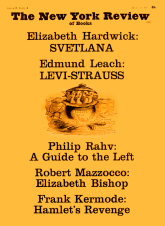To the Editors:
I have two stories to tell about the role of the authorities in the Detroit riot. They come from women living in a predominantly Negro project for the poor on the lower West Side in the heart of the riot area. One of these women told me that on Monday she had gone to do some shopping on Trumbull Ave. at the local A&P. Across from the A&P was a dime store. What she refers to as an armed official in uniform (doubtless a national guardsman) kept calling out to the passing women to come and loot the store, assuring them that it would be blown up in any case.
The other story is comparable. It comes from a mother of young children. She states that a policeman told her children that they could take anything they like. “It’s not stealing. They’re giving it away,” he said. Her neighbors confirm that police officers actively encouraged people to loot. According to these women, an officer said, “Get what you can now because by three o’clock the Federal Troops will be here.”
My own experience with police officers is consistent with these stories. Police officers have made it patently clear to me that they saw before them only two choices in dealing with the Negro in the inner city—outright suppression (that is, brutal assault) or laissez-faire. As an investigator for the Michigan Civil Rights Commission, I was struck with the capacity of police officers to manipulate the Negro into an act of aggression and then follow this manipulation with a brutal assault on his person.
I do not generally subscribe to conspiracy theories, but the Detroit police have repeatedly asserted that police officers refuse protection to Negroes in the inner city in protest against controls placed on them. I would infer, both from my own past experience with the police while working for the Commission and from what women in the inner city have told me, that when ordered not to shoot looters, a significant number of police retaliated by encouraging them. It was certainly an effective tactic. Everyone in Detroit now bemoans the limits we have placed on the police.
I do not want to suggest that the Detroit was precipitated by active instigation by the police. That would be absurd. I do suggest, however, that they were effective in escalating it.
The origin of the riot is beclouded in speculation. One professor at Brandeis University studying violence claims that teen-agers threw rocks into store windows and set it off. His views were reported in all seriousness in the Detroit press. One of my neighbors works for the city and was assigned to the riot area at dawn on Sunday. He states that Twelfth Street (the street where the first riotous acts occurred) was full of people of all ages—night people. According to him the problem confronting the city was that the Tactical Mobile Unit had gone off duty at around 3 A.M., Sunday. (The T.M.U. are the police trained in riot control.) They were not effectively remobilized until after 4 P.M. that day. The evidence he has collected indicates that professional criminals used the opportunity to start stealing. This is consistent with the scenes on television of men in shiny Cadillacs pulling up in front of his store with a truck.
What emerges is that a tense incident occurred on Twelfth Street. The trained professionals were off duty, a riot situation developed, the concentration of whatever police protection there was available in the inner city was directed to the core riot area which gave the professional criminal an open hand, some police officers responded to an order not to shoot with active instigation, and the city took to the streets.
There has been speculation as to whether or not this was an interracial riot. One of my white friends told me that her unemployed white sons brought her a looted $400 chair (the price tag attached) and could not understand why she wouldn’t let them bring it into the house. A Jewish friend with a clothing store in a mixed Polish and Negro neighborhood told me that both his Negro and white neighbors protected his store with force of arms. Driving down one street in the inner city I saw a Negro and a white man both armed with bayonetted rifles sitting on camp chairs guarding a store. It appears that people responded according to class, not racial lines.
The most interesting conversation I have had about the riot took place with my landlady and friend. She is a middleclass Negro. Although she was greatly distressed the first few days of the riot, she has now arrived at the position that it was a successful revolution. I agreed that it was certainly an act of protest and perhaps revolutionary in its implications. “But how can you call it a successful social revolution,” I asked her, “After all, there was no effort to take over the auto industry for example, or even attack it?”
“But that’s private enterprise,” she responded. “You can’t take over the auto industry, and besides they [the poor] wouldn’t know how to run it anyway.”
The most interesting observation I have made is that, like in the Watts riot, the used and new auto lots escaped the riot without a scratch. (Pardon, the newspapers did report one broken car window.) One drives down a street with burned out homes and stores and then one comes on an array of shiny unblemished cars.
We Americans know what’s worth preserving.
Laura Carper
Detroit, Mich.
This Issue
October 12, 1967



